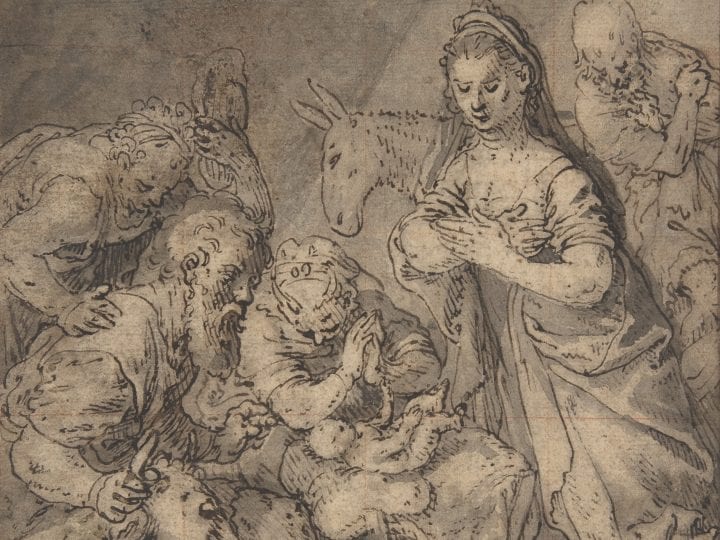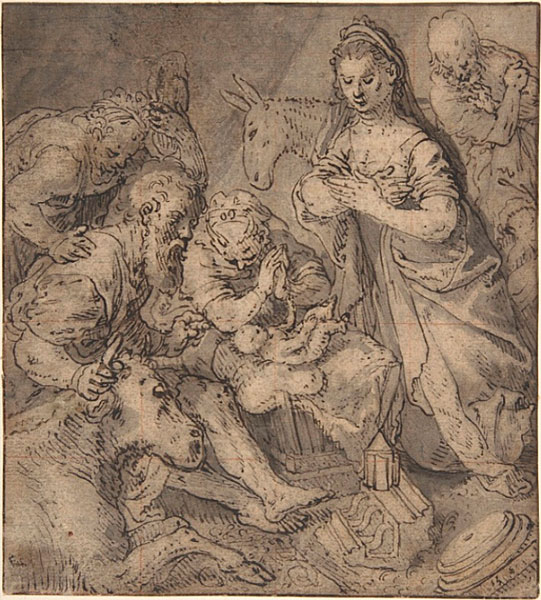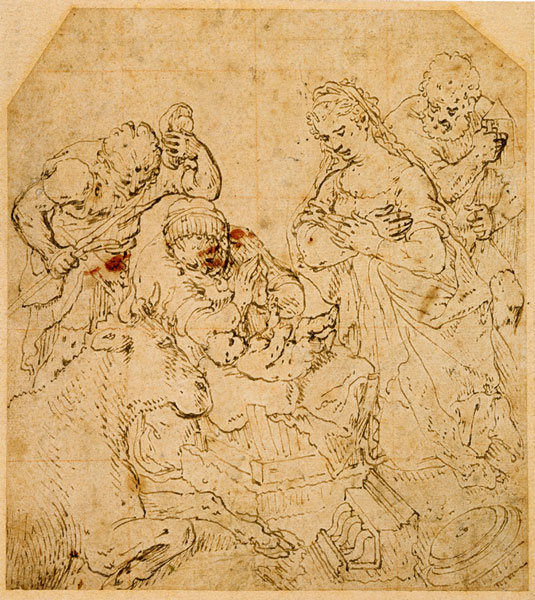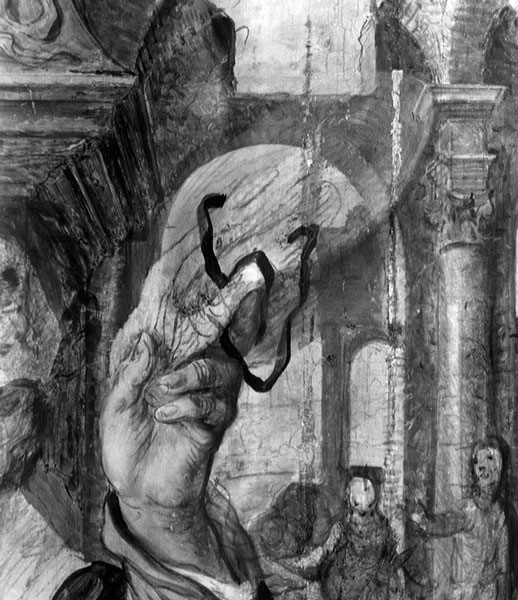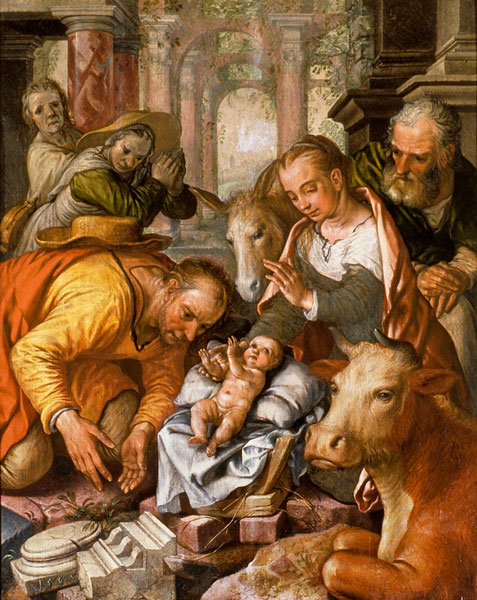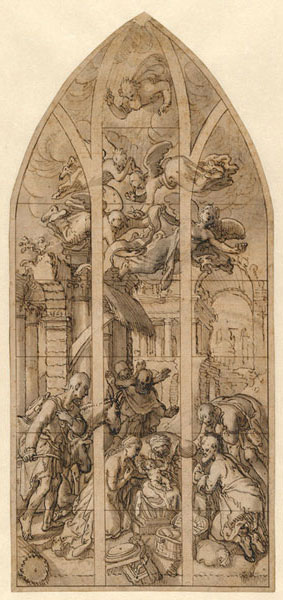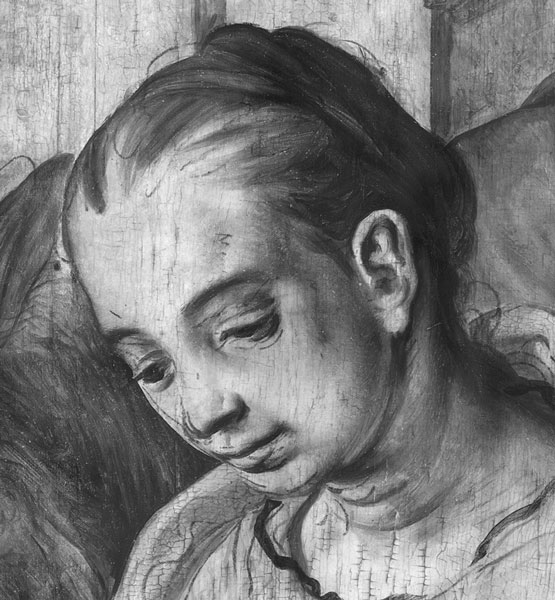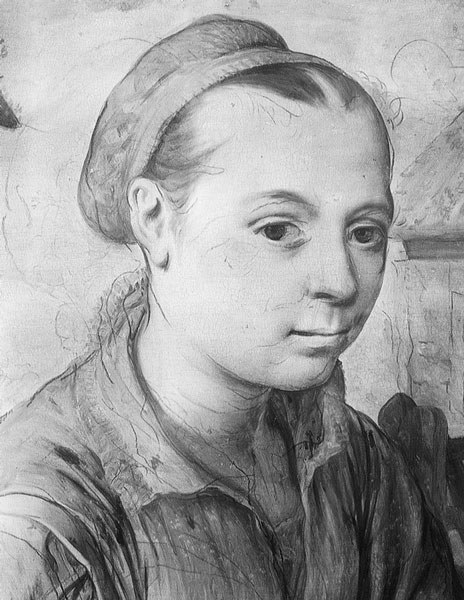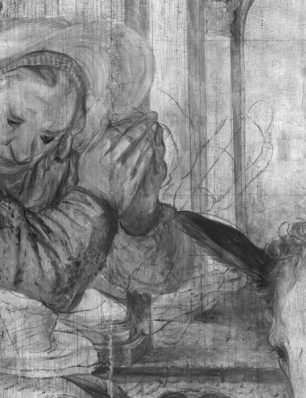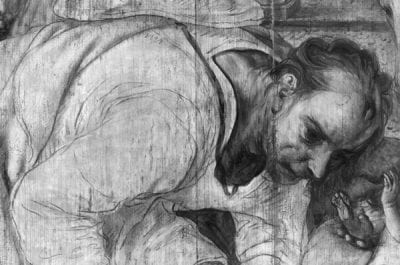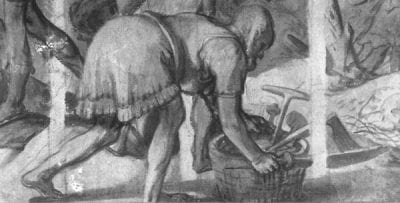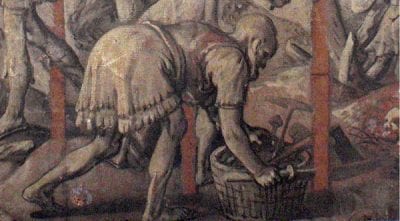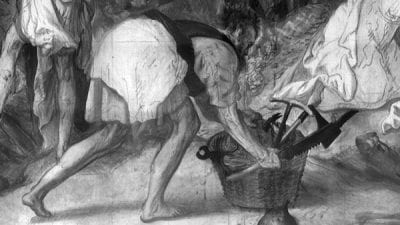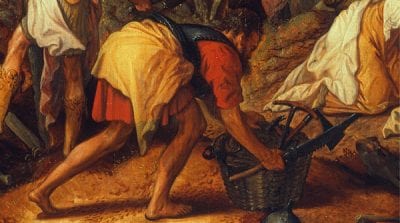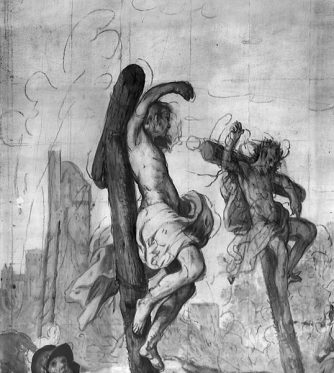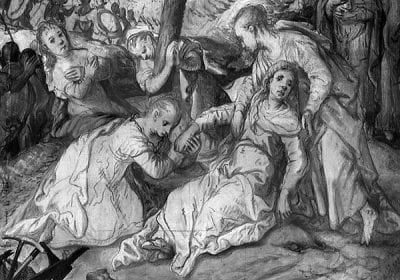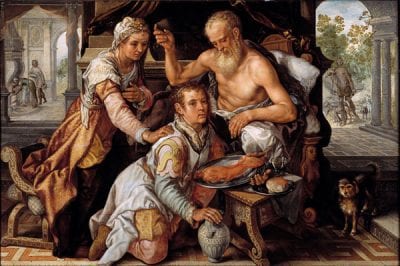This article compares a number of drawings and related paintings by the Antwerp artist Joachim Beuckelaer: three drawings of the Adoration of the Shepherds and two related painted versions of the same subject; two oil sketches on paper, each depicting half of a Crucifixion scene, and the associated painting; and a drawing and painting both representing Isaac Blessing Jacob. The paintings were examined with infrared reflectography (IRR), revealing for study the important intermediary step of the underdrawing. The article demonstrates how the artist began with a design on paper and worked toward the final paint stage in a continuous and supple design process that incorporated numerous shifts and changes in composition. It also shows that the use of squaring on drawings and paintings is not as straightforward as might be expected. Similarly, the deft handling of workshop models, as well as certain procedural idiosyncrasies, indicates that in most cases, instead of acting at the behest of his patrons, Beuckelaer himself was the one responsible for the changes.
Research with infrared reflectography (IRR) has revealed that underdrawings in the paintings of Joachim Beuckelaer (Antwerp, ca. 1535–1575) often have a sketchy and spontaneous character. While this might indicate that the artist was working out the first ideas for his compositions directly on the support, this was certainly not always the case.1 In Beuckelaer’s atelier there must have been a selection of drawings, sketches, studies, and models that were consulted during the painting process. Some of these shop drawings have in fact been preserved, and it is also known that Beuckelaer used other outside models during the creation of his works, such as compositions by his uncle and master Pieter Aertsen, the architectural books of Sebastiano Serlio and the Hypnerotomachia Poliphili.2 Still, the models that are known to us are probably only a portion, if not a tiny fraction, of what the artist assembled to support the production of paintings.
Various sources report the use of such models in sixteenth-century workshops. An often-cited example is the legal case between Gerard David and Ambrosius Benson involving two trunks with working drawings and models for paintings and miniatures. The documents deriving from the lawsuit show how much importance was attached to this material. Similar items were also frequently listed in the inventories of painters’ shops. Moreover, IRR research has brought to light ample evidence for the use of models.
We know that Beuckelaer’s master, Pieter Aertsen, used models in his shop. Not only did van Mander mention that cartoons existed for twenty-five of Aertsen’s altarpieces,3 Yvette Bruijnen’s research has also shown that Aertsen reused the same partial cartoons for certain still-life motifs that repeated from one painting to another.Thus, Beuckelaer almost certainly became acquainted with the handling of models during his apprenticeship.Unfortunately, most of this working material has been lost over time.
A number of Beuckelaer’s surviving drawings can be related to paintings. There are three drawings and two paintings depicting the Adoration of the Shepherds (figs. 1, 2, 3, 11, 12); two oil sketches on paper, each with half of a Crucifixion scene, both related to a representation on panel (figs. 17a, 17b, 18); and a drawn sheet that can be linked to a painted composition with Isaac Blessing Jacob (figs. 25, 26). IRR has detected underdrawings in the paintings, revealing the essential step between the design on paper and the finalized work and elucidating how the drawings functioned as models. By setting up the comparisons discussed in this article, information can be obtained showing how these models were assimilated into the creative process. As will become apparent, it was typical of Beuckelaer to adapt and revise in each compositional stage as he worked toward the end result. Before beginning the analysis, however, it is necessary to provide a short introduction to Beuckelaer’s drawings.
Beuckelaer’s Existing Drawings
In the 1989 volume of Nederlands Kunsthistorisch Jaarboek, Wouter Kloek published a study devoted to the drawings of Aertsen and Beuckelaer in which he assembled Beuckelaer’s drawn oeuvre and noted important characteristics of the artist’s works on paper. He determined that all of the drawings originated between 1560 and 1565/7, with most done in the first three years of the decade. Five of the fourteen sheets derive from 1562. Half of the drawings were designs for stained glass, both monumental as well as smaller windows. Two even included options for carrying out the window as either a round or a square shape. Kloek also described another completely new and significant aspect of Beuckelaer’s studio practice: the making of oil sketches. Six sketches–a series of four sheets and the two loose Crucifixion halves–were executed with oil paint on paper.4 Kloek assumed that the four Old Testament sketches, with one in the series dated 1565, were intended as designs for prints. Furthermore, the author noted that squaring occurred on five of the drawings.
Kloek’s completely justified de-attribution of the Market Scene in the Lugt collection led to another important finding. With the exception of two sheets with possible historical subjects,5 all of Beuckelaer’s drawings depict religious scenes. For a painter who is seen primarily as a specialist in market and kitchen scenes,6 this is not an insignificant observation and indicates that Beuckelaer was not working exclusively in this genre during the first half of the 1560s.
The Relationship between the Existing Drawings and Paintings
Adoration of the Shepherds
The first instance of a drawing, which is associated with a painting, is the Adoration of the Shepherds, dated 1560, in the Metropolitan Museum of Art (fig. 1). This drawing is Joachim Beuckelaer’s first known work, deriving from the same year during which the artist married and enrolled as a master in Antwerp’s Guild of St. Luke. Beuckelaer’s first paintings appear the following year and are dated 1561. Kloek suggested that the drawing may mark the development of a new prototype intended for later production. Although he attributed the drawing to Beuckelaer, he still assumed that it was executed in Aertsen’s workshop. This new composition does indeed pay tribute to Aertsen’s paintings of the same subject, such as the Adoration of the Shepherds in the Amsterdams Historisch Museum and the one in the Musée des Beaux-Arts, Rouen. Another drawing, which appeared on the market not so long ago and is now in the Teylers Museum in Haarlem, depicts the same subject and is stylistically related to the 1560 drawing; it represents a subsequent phase in the genesis of this composition (fig. 2). Since it seems to be a step farther in the direction of the final work, to be discussed below, it seems logical to assume this drawing was made following the one done in 1560. Since there are no indications for window subdivisions in either drawing, both must have been made as preparatory designs for painting.
In elucidating how Beuckelaer gradually worked toward the final composition, the two drawn versions must first be compared before determining their relationship to the version on panel. Both drawings show small changes.7 Most are slight revisions, such as the adjustment of Mary’s headdress in the 1560 drawing or the ox’s hoof in the second sketch.The way the artist adapted the composition in the second drawing relative to the first one is indicative of his approach. The composition is made more compact overall, and the figures are pulled closer together. The seated shepherd on the left side and the donkey in the background have both been omitted. The standing shepherd’s position has been adapted to the new situation, and he now holds a shepherd’s crook in his right hand. Leaning forward with her head bent, Mary appears more focused on the Christ child. The lantern, placed below on the fragment of a column base in the first drawing, is held by Joseph in the later drawing.

Both drawings, and especially the second, must have provided the point of departure for the Adoration of the Shepherds in the church of St. Ursula in Cologne (fig. 3). It appears, however, that once the drawings were done, the creative process was far from finished, since further changes can be observed in the painted surface. The figural group has become even more compact, and the background has been given form by the addition of classical architecture reminiscent of Sebastiano Serlio. The column base with eagles in the upper left is a direct borrowing from Serlio’s Book III. Adjustments have been made in all of the foreground figures. Compared with the drawings, Mary’s crossed hands and the shepherdess’s folded hands have been exchanged. The Christ child’s arms and legs have been altered. The fold pattern is more complex in the cloth wrapped around the cushion under the Christ child, and the original wooden crib has been transformed into a large, stone block. The shepherd on the left no longer carries a crook but holds his right hand open, while making an elegant gesture with his other hand and holding a much larger hat. The ox in the foreground now glances out to the viewer rather than looking in the direction of the Christ child. Finally, the date–1565–has been added on the column base that is angled downward in the lower right corner, just as in the drawing from 1560.
IRR research of the St. Ursula painting reveals that a number of the modifications that had been made relative to the drawings were already present in the layout stage. This is not true, however, of all of the changes. Given the fact that both drawings have been squared with red chalk, perhaps the artist originally intended to transfer the composition of the drawing directly to the panel.8 Yet this plan must have been abandoned even before the underdrawing was begun, because there is no squaring to be seen on the panel, either with the unaided eye or with IRR.
Although the exchanged hands of Mary and the shepherdess were included in the underdrawn layout, many other alterations and modifications occurred during the painting process. In several instances these changes were made as the composition was being worked out in paint, since in the underdrawing stage they correspond to the preparatory sketch. It can be seen with IRR–and also partially with the naked eye–that a bent arm and hand holding a crook were underdrawn under the shepherd’s arm that is currently visible, stretching out below to his open hand (fig. 4). This exactly matches the detail in the second drawing. The bent arm was not only underdrawn in black chalk, it was also taken (at least in part) into the paint stage since (dark) portions of the arm and crook are visible underneath the present sleeve. The first position was apparently unsatisfactory, and it was decided during the painting process to give the arm its present form, perhaps to better close off the composition on the left side. This is an excellent illustration of the ongoing creative process that is typical of Joachim Beuckelaer’s manner of working.
A similar change occurs in the hand and hat of the same shepherd. The underdrawing did not predict the final form here either. The IRR composite shows that the hat was underdrawn much smaller, more closely matching the drawing (fig. 5). Only after the architecture was (almost) completely finished was it decided to enlarge the hat with a rim and rounded top.
The IRR research shows that, compared with the drawn sheets, this searching for the most satisfying form also occurs elsewhere in the composition. In the figure of the Christ child, the furthest arm has been drawn under the arm that is now the nearest (fig. 6). The underdrawn arm is thus closer to that in the two drawings.
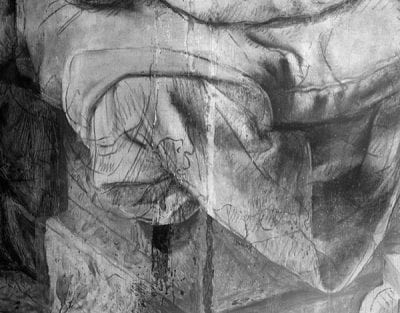
The underdrawing is difficult to interpret in the stone block on which the Christ child lies. While both drawings include a wooden crib, a stone block has been depicted in the paint surface. The underdrawing under the fabric hanging from the cushion shows several short, straight lines as well as some forms that are rounded on the bottom (fig. 7). These are suggestive of the slats of the crib, as they appear in the drawings. It is possible that the crib was still planned during the underdrawing stage and then, during a later creative phase, was replaced by the stone block. Choosing to add the cushion and cloth had already taken place before the underdrawing was begun. Nonetheless, other modifications were still introduced as the image was worked out in paint.
The analysis of the IRR images reveals that as compared with the previous design the artist began to make some changes as soon as the underdrawing was being laid out. In those areas, however, where the painter continued to follow the drawn model on paper, he then deviated strongly from the underdrawn layout during the next working phases. Sometimes this occurred while the underdrawing was being executed, as in the crib, or sometimes in a later stage during the application of the paint layers.
Another distinct feature of the underdrawing is the density of hatching, especially in the heads of Mary and the shepherdess (figs. 8 and 9).9 Beuckelaer’s underdrawings from around 1565, the date of the painting, generally exhibit less worked out modeling in the shadow areas (see figs. 13, 14). In this respect the underdrawing of the Adoration is not only closer to the two drawings but also to underdrawings in earlier paintings by Beuckelaer, such as the Two Market Women in Vienna (fig. 10) or the Market Scene with Ecce Homo in Stockholm, both dated 1561.10 This suggests that the underdrawing was executed earlier than 1565, the date on the painting. The work may have stood for a while in the studio before it was finished and the date added.11
It is not impossible that the St. Ursula painting functioned as a model in the shop for a certain period of time. There are, in fact, a number of almost identical replicas of this composition.12 What is especially notable is that these copies–which show some slight differences–are dated 1561 to 1562.13 If the Ursula work was available for a period in the shop, that could explain the early dates of these versions. It is also possible, however, that these are later copies which have been incorrectly dated too early. None of these works has been examined by IRR, but since without exception they all repeat the painted surface of the St. Ursula painting, the work in Cologne must have been the basis of these examples.
Another Adoration of the Shepherds, dated 1565 as well, but also provided with Beuckelaer’s monogram, is in the church in Court-Saint-Etienne (fig. 11).14 The evolving composition has been revised by combining and manipulating elements from the painting in Cologne as well as the two earlier drawings. Also playing a role in this process are components of another work on paper, a design for a monumental stained-glass window with the Adoration of the Shepherds in the Kunsthalle, Hamburg, dated 1563 (fig. 12).15
Mary and Joseph are still positioned on the right side of the scene, as they appear in the compositions discussed above. Their postures, however, have been altered, and Mary now tenderly holds the Christ child’s right arm. The child is foreshortened and placed on a diagonal, as in the Hamburg drawing, and in contrast to the profile presentation in the two other drawings and the panel in Cologne. In the Court-Saint-Etienne panel, the positions of the child and Mary are the reverse of the figures in the Hamburg sheet. Whereas in Cologne the artist opted for a stone block, the Christ child now lies in a wooden crib as in the three drawn versions.
The adjustments in the shepherd in the left foreground are more radical. This figure is now shown nearly full length, because the ox and antique fragments have changed places. Beuckelaer seems to have created this form by combining, in reverse, the kneeling figure in the foreground of the Hamburg drawing–perhaps Joseph–with the sharply bent figure just behind. In addition, two more shepherds have been added in the left background of the painting.
The underdrawing in the painting at Court-Saint-Etienne differs considerably from that in the St. Ursula panel.16 In contrast to the work in Cologne, it is less heavily shaded, and as such, more closely related to works by Beuckelaer that date around 1565. This can be seen in the comparison of the head of Mary with that of the Vegetable Seller in Kassel (figs. 13 and 14).17
In the Court-Saint-Etienne work, there are fewer modifications relative to the underdrawing, perhaps indicating that the composition was already established to a greater degree before the underdrawing was begun than was the case in the Cologne painting. The most obvious change appears in the shepherdess on the left (fig. 15). In the underdrawing her hands were larger and longer, and her head was bent forward more. The lines visible just above the underdrawn hands may indicate that the shepherdess was intended to hold some sort of object. During work on the panel, the painter continued to search for this figure’s final form.
There are in addition a number of small alterations that are more rightly regarded as corrections than radical compositional changes. It is typical of Beuckelaer that he would underdraw a short sleeve, such as that on the right arm of the shepherd in the foreground, and then finish it in paint as a long sleeve (fig. 16). Other slight modifications occurred during the application of the paint layers, such as in the cloth around Mary’s shoulders and in her hairdo, which was extended on the top. There is thus also evidence in this painting for ongoing change as the image was finalized, even though to a lesser degree than in the painting discussed earlier. It would not be surprising to find that the panel at Court-Saint-Etienne was preceded by a variant that closely resembled this composition.18
The Crucifixion
Two oil sketches on paper in the Louvre–designs for stained-glass windows–provide the basis for another analysis. Each sheet depicts half of a Crucifixion scene (figs. 17a and 17b)19 and may be compared to a painted Crucifixion (also in the Louvre), where the two halves have been united into one composition (fig. 18).20 Both the painting and the oil sketches have been examined by IRR, yielding not only a comparison between the underdrawing and the two sketches in their final form but also between the underdrawing and the final result in the painting. This gives good insight into Beuckelaer’s working method, which in this case is surprisingly dynamic.
Although at first glance it seems that the sketches have simply been joined together in the painting, this is clearly not the case, since the combination has resulted in a number of compositional shifts. Although a narrow strip may be missing along the bottom edge of the sketches, this cannot entirely explain the expansiveness of the scene on panel. A greater sense of depth has been achieved by the larger amount of space above and below the figures. The composition has also become a tall rectangle, in contrast to the much wider format of the two sketches. The bending man with the basket in the foreground has been moved to the right, as the two halves have been merged and newly created hills establish a link between the distant landscape and the foreground. The composition has been heightened by raising the crucified figures high on their crosses, where they are silhouetted above the people on the ground. This probably necessitated lifting the buildings on the right and creating completely new ones on the left.
Over and above these compositional interventions, all sorts of modifications occur in the figures. The positions of the Virgin Mary’s and John’s heads have been shifted in a way comparable to the exchange of hands between Mary and the old shepherdess in the Cologne Adoration of the Magi. And there are changes in the heads and arms of the two thieves. In a very free way, the artist has made creative leaps away from the sketches.
IRR was able to detect underdrawings in both sketches on paper as well as in the panel, all executed in a dry material.21 In the sketches, summary indications appear in the form of contour lines (figs. 19a–b), while the panel exhibits a more thoroughgoing preparation that includes hatching (figs. 20, 21c, 22–24). Squaring, done at a very reduced scale given the size of the work, has also been detected in the panel (fig. 20).22 Despite the fact that a grid pattern occurs on a number of Beuckelaer’s drawings, it is lacking in the oil sketches and cannot be seen with either the unaided eye or IRR. This raises the question of what the precise relationship was between the sketches and the painting. Perhaps Beuckelaer created another design that formed a link between the sketches and the painting in the Louvre, and it was this intervening version that was squared. Still, it is curious that the underdrawing appears so loose and sketchy, with frequent changes between it and the paint stage, when squaring is normally used to transfer a composition that has been fully worked out in all its details. Another possibility is that the compositions of the oil sketches were transferred freehand to the panel, and that they were squared only afterwards. In this case, the composition established in the underdrawing would be used for any further repetitions. Which of the two possibilities is correct cannot be determined with the material available at present.
Based on the layout in the underdrawing of the united composition, it can be established with certainty that the two oil sketches preceded the painting on panel. There are forms visible in the underdrawing that match those in the sketch, but they have been altered in the paint stage. This can be seen in the figure with the basket of tools (figs. 21 b–d). His costume was underdrawn following the sketch: there is a fold line between the legs, and the double layer of fabric has a striped pattern underneath. In paint, the artist has arrived at a completely different form, with a pointed piece of cloth hanging over the skirt underneath. This shape was added on the already-painted background, indicating that changes were still being introduced during the painting process. As in the sketch, the upper torso of this figure is also longer in the underdrawing, with arms and head positioned farther to the right. Comparison with the first version of this figure, drawn in chalk in the oil sketch, gives further insight into Beuckelaer’s working process, since changes also occur in the sketches relative to the underdrawing stage. Chalk lines in this figure’s left foot show that it was placed flatter on the ground, while in the paint stage of the oil sketch, the heel is higher, and in the painted version on panel, the man stands even more on his forefoot. The gradual development of this motif suggests that the man’s movement was meant to imply he was packing up his basket in order to leave the scene.
In the underdrawing on the panel, the heads of the two thieves are closer to the oil sketch as well (fig. 22). In the sketch, the good thief, who is on the right, looks up to heaven, while the thief on the left looks down. In the painting this figure looks toward his fellow-sufferer, although the underdrawing shows that his head was originally tilted down, just as in the sketch. The positions of the Virgin Mary’s and John’s heads were exchanged even before the underdrawing had been laid out, while other revisions, as in the costumes of the figures under the cross, correspond again to the oil sketch (fig. 23). In the leg of the kneeling Mary closest to the foreground, chalk lines can be observed defining a strip of cloth as it appears in the sketch. A line is visible in her right arm that matches the short sleeve seen in the oil sketch. All of these forms, however, were adjusted in the final paint surface.
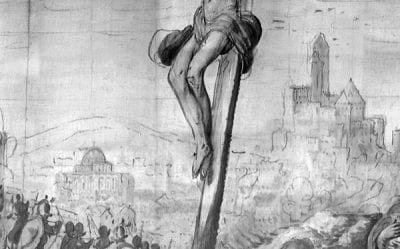
The architecture shows changes as well (fig. 24). The towers on the right side were underdrawn lower, which might be indicative of the fact that, as compared with the sketches, the height of these motifs had to be adjusted. It is noteworthy that the higher positions of the towers were also underdrawn, proving that the modification had already taken place during the layout phase.
Although it is clear that the oil sketches and the panel are closely related, the presence of squaring on the panel makes it impossible to define what the exact relationship between them might have been. The oil sketches clearly came before the panel, and once again, Beuckelaer remained closer to his models in the underdrawing, while making deviations during the painting process. The modifications and adjustments of form are constant, not only in relation to the model on paper, but also in the underdrawing stage, and during the application of the paint layers. Changes are introduced at every phase of the working process that are creative and exhibit a distinct personal character. This leads to the strong impression that Beuckelaer carried out this process without the help of assistants.
It is remarkable that a Crucifixion design in two halves, probably intended for a specific location with two windows, could be merged into one painted composition. The process resulted in an unusual asymmetrical Crucifixion scene, with the two thieves on the left and the crucified Christ on the right.23
Isaac Blessing Jacob
The last case study concerns a single sheet, a drawing dated 1561 and preserved in the Herzog Anton Ulrich-Museum in Braunschweig (fig. 25). It depicts Isaac Blessing Jacob (Genesis 27, 1-31) and relates to a panel of the same subject in the Museum Catharijneconvent, Utrecht, with the date 1568 (fig. 26).24 Compared with the representation on paper, the painting exhibits so many radical changes that an intervening drawing or painting cannot be ruled out. Nonetheless, by comparing the drawing in Braunschweig, the underdrawing, and the painted surface of the Utrecht work, it can be shown that the working procedure is entirely in keeping with Beuckelaer’s overall approach, as described above.
Rebecca and Jacob are depicted to the right of Isaac in the drawing. In the painting, however, they have been reversed, shifted to the left of the blind patriarch, and altered somewhat in posture. The repositioning of Rebecca and Jacob required Beuckelaer to foreshorten the upper torso of the elderly man and adjust the direction of his glance. He also made the lower half of Isaac’s body much less noticeable. Thus, the main figural group has been made more compact in the Utrecht painting–a compositional manipulation that has been signaled elsewhere in Beuckelaer’s working procedure.
Another feature of the painted version is a change in iconography. In the drawing Jacob is seen from the back, but in the painting he is depicted more from the front. This revision brings the goat’s hide into view, which had been placed by Rebecca around her son’s neck in order to deceive Isaac into thinking that Jacob was actually his older brother Esau, who was more hairy. Although the biblical account mentions that the hide also covered the hands, all we see in the painting is a fur cuff around Jacob’s right wrist. With his other hand, the deceiving son holds a platter containing the goat, now prepared as a meal, a motif that is lacking in the drawing. This makes it evident that Jacob is the one offering the meal to his father, as is further suggested by the placement of his other hand on the jug of wine. Rebecca’s role as initiator of the intrigue is implied by the hand she presses on her youngest son’s shoulder, a position quite different from her more neutral stance in the drawing. Shifting the figural group to the left caused the background vignette on the right to be given greater emphasis. Here Esau is depicted frontally rather than from the back, and, from the trophy he holds, it is apparent that he is returning from the hunt rather than departing. This is a more logical moment to depict, since it was shortly after the blessing that Esau returned from the hunt to discover the deception. Changes also occur in the background vignette on the left, where the meal is being prepared for Isaac. The Corinthian fireplace, which has been taken from Sebastiano Serlio, has been transformed into a Doric one.25 As is usual with Beuckelaer, the fireplace has been foreshortened in the painting while, in Serlio, the motif is seen straight-on.
The drawing has been squared in red chalk, but the painted representation deviates so sharply from the drawing that it is impossible to assume the grid could have been used to transfer the composition. And indeed, no squaring could be detected in the panel, either with IRR or with the naked eye. The underdrawing does show–once again–that the composition was not fixed in the layout stage and that a number of underdrawn motifs are closer to the drawing on paper. It again becomes apparent that Beuckelaer was gradually working toward the final manifestation of the image.
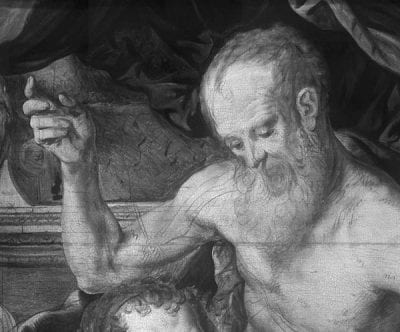
The underdrawing makes it clear that the artist was sketching freely as he prepared the composition on the panel. This can easily be seen in the changes in Isaac (fig. 27). Both arms were different in the underdrawing, and a number of lines were repeated as the artist searched for the final form of the upper arm giving the gesture of blessing. The underdrawn right arm was intended to be much more foreshortened than in the final paint surface. This was true of the underdrawn left arm as well, although to a lesser degree. Thus the arms were originally closer to the drawing (fig. 25), where Isaac’s torso is also seen more on an angle. In the painting, the old man’s leg appears as a vague form (fig. 28). When viewed with IRR, it is clear that Isaac’s knee appears behind Jacob’s head, but it is awkwardly placed relative to the rest of his body, perhaps explaining why it was eventually painted out. As regards the figure of Rebecca, her eyes and chin were underdrawn lower and her head appears to have originally been bent more forward (fig. 29). Once again, it can be seen that the underdrawn figures more closely correspond to the forms in the independent drawing.
In IRR Jacob’s costume has decorative motifs (fig. 30). While these, on the one hand, differentiate the figure from the simpler depiction in the drawing, they also show that the decision to add decoration was made before or during the underdrawing stage. The right sleeve was initially planned to be cut off short and straight, over a longer one, just as in the Braunschweig drawing and in other examples mentioned above. It was only at a later stage, in chalk, that the lines of decoration were added to the upper arm, indicating once again that changes continued to be made during the underdrawing phase. This motif had still not achieved its definitive form at this point, since if differs from what is now visible in the surface paint. The decoration on the upper leg was not executed at all (fig. 28). What is also obvious is that the fur cuff at the wrist was not indicated as such in the underdrawing. Apparently this was important enough iconographically that it had to be added or enlarged in a later stage. Dark paint, however, makes it difficult to determine whether or not the goat skin on Jacob’s neck was already present in the underdrawing.26
The underdrawing in the furniture again corresponds to the drawing. The feet of the table holding bread and a wine glass curl inward in the paint surface, while they curve out in the underdrawing, as they do in the drawing (fig. 31). The feet of Rebecca’s stool curve outward too (fig. 32), indicating that the stool originally showed more similarities to the model in the drawing as well.
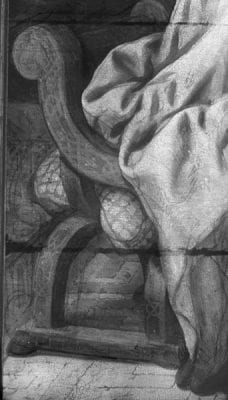
The roast goat, which is important to the narrative, was probably only added during the application of paint. The tin platter holding the meat was painted with a mixture of pigments impenetrable to IRR, and as a result, it is impossible to detect any contours that might have defined the shape of the goat. There are, nonetheless, no lines to be seen inside the form of the goat, nor is there any preparation in chalk for the goat’s legs, which stick out over the edge of the platter. Moreover, the goat’s head and legs have been added on top of the already-painted figures of Jacob and Isaac. This leads to the conclusion that the roasted meat was added only as work on the composition was still progressing. Because the goat was delimited by the paint of the platter, the addition cannot have occurred in the very last stage of the creative process.
In this case, as in that of the St. Ursula painting, the very elaborate underdrawing seems to be earlier than the date of 1568 given on the painting. The underdrawing might be closer to the drawing done in 1561. On the other hand, dendrochronology has shown that use of the panel before 1568 is not probable. This work may have required a more detailed underdrawing, since the subject was an uncommon one for Beuckelaer at this point in his career and had specific iconographic demands. In the second half of the 1560s Beuckelaer focused more and more on market and kitchen pieces. The deviations the artist made from the drawing on paper may also have required more searching in the underdrawing for satisfactory forms and positioning. Since it is likely that this painting is the result of a commission, the more elaborate underdrawing may have served additionally as a contract design, a so-called vidimus, for the person ordering the work.
Concluding Remarks
The comparisons above between drawings, underdrawings, and the painted surfaces of several works by Joachim Beuckelaer lead to a number of conclusions. First, it appears that in the artist’s design process, no distinction was made on the basis of the medium of the final work. This is exemplified by the drawing for stained glass with the Adoration of the Shepherds in Hamburg, which played a role in the evolution of the painting in Court-Saint-Etienne, and the two oil sketches in the Louvre, which were transformed into a painted Crucifixion, also in the Louvre. Designs for stained-glass windows were thus assimilated by the studio into the process of creating painted compositions.
It has been shown that the painter generally took the same approach to his drawn models. In each case the artist revised the composition as compared with the original design. There is a general similarity in the way the artist compressed the compositions, as evidenced by the works in Cologne, Court-Saint-Etienne, and Utrecht. Reversals of figures and sections of compositions have been noted (Court-Saint-Etienne and Utrecht), as well as exchanges in posture between two figures (Cologne and the Louvre). Also, research has revealed that in a number of cases the underdrawing is closer to the model than the final painted solution. Designing did not stop with the execution of a drawing on paper but was ongoing, continuing into the layout of the underdrawing as well as into the application of the paint layers. Yet this appears to have occurred to a lesser extent in the Court-Saint-Etienne painting.
Squaring is another, related issue. Even if a grid pattern can be ascertained in a drawing or in an underdrawing, it does not necessarily follow that there is a direct connection between the squared drawing and the associated painting. Squaring on a drawing does not always indicate that it was actually put into use transferring the composition to the final support.
The many modifications that were revealed by comparing drawing, underdrawing, and painting bring up the question of who dictated these changes. Was it the painter himself, or did a client or commissioner determine the final appearance of a work? Examples are known where the person ordering the work exerted a direct influence on the preparation or the painting activity leading to the final image. Archival documents relate that while work was proceeding on the Coronation of the Virgin by the Bruges painter Albert Cornelis, the commissioners lodged a complaint because the work had not been painted according to agreed-upon requirements. According to the court documents, the painter was supposed to paint the seven choirs of angels with their proper attributes. Eventually it was decided that Cornelis would be allowed to finish the project, but that he must do that following the established requirements. IRR research of the panel makes it clear that the painter must have heard the commissioners’ complaint while he was at work on the painting. In the underdrawing and also in the first paint layer, the angels were depicted with folded or raised hands, but no attributes. In their final forms, the angels take more varied postures, and they are depicted with their correct attributes. Pieter Pourbus’s Triptych with Joos van Belle in the church of St. James, Bruges, provides another example. A modello has been preserved with inscriptions that prove that the drawing served as a vidimus for the triptych. In the drawing Mary is shown drying her tears. Apparently Van Belle was not satisfied with this motif, and he agreed with Pourbus that the artist would paint Mary with crossed arms, as the inscription along the lower edge states. IRR examination of the panel revealed that the correction in Mary’s posture had already been made by the underdrawing stage. Although small changes continued into the painting stage, distinct steps can be discerned in the process: the planning of the composition in the drawing, the adjustment as ordered by the client, and its subsequent execution on the panel. This differs markedly from the ongoing creative process that distinguishes Beuckelaer’s work. Since the changes that occur in Beuckelaer’s works are of like kind, it is probable that the artist himself had considerable input in the actual process of making the revisions. It is also quite likely that drawings functioned in the atelier as part of a collection of models from which clients could make a selection. The actual models–whether a drawing, underdrawing, or painting–may have played a role in the purchasing process by providing a basis for suggested modifications. It must still have been the artist, however, who was the most decisive factor. The constant adjustment of forms during the drawing and painting process implies that a fixed idea of the composition could never have been established with the client. It is, of course, also feasible that some of these works were intended for the open market, making it even more evident that modifying and changing compositions was an artistic imperative for Beuckelaer.
